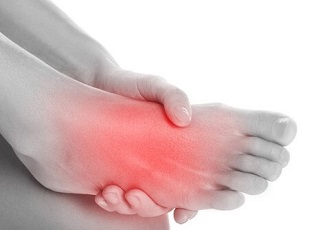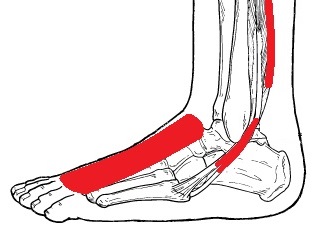- Home
- Common Foot Problems
- Tendonitis Guide
- Extensor Tendonitis
Extensor Tendonitis
Written By: Chloe Wilson BSc(Hons) Physiotherapy
Reviewed By: FPE Medical Review Board
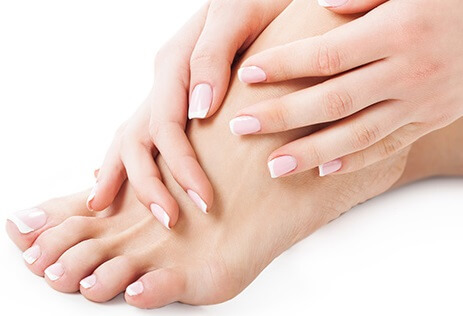
Extensor tendonitis is a common problem that causes pain across the top of the foot.
This form of foot tendonitis is caused by inflammation or irritation of the tendons that pull the toes up.
Typically, tendonitis of the extensor tendons develops due to repeated friction across the top of the foot or excessive pressure from a poorly-fitting shoe.
Here, we will look at the common causes, symptoms and treatment options for this common foot problem.
What Is Extensor Tendonitis?
Let's start by looking at how tendons work. Tendons are tough, fibrous tissues that connect muscles to bones. The extensor tendons join the muscles on the front of the lower leg to the toes. They pull the toes upwards away from the ground.
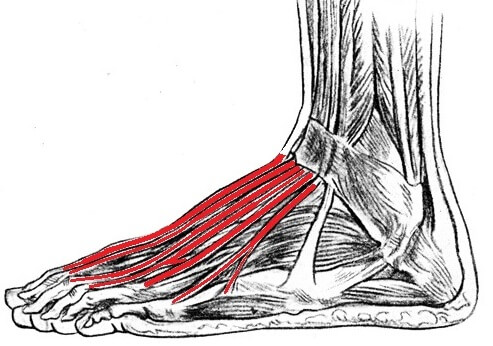
The two main toe extensor tendons are:
Extensor Hallucis Longus: which lifts up the big toe
Extensor Digitorum: which lifts the other four toes
Both tendons run down across the front of the ankle, across the top of the foot and then fan out attaching to the tips of the toes.
The extensor tendons sit between the skin and the bones and there is little padding around them, making them prone to injury resulting in top of foot pain.
With extensor tendonitis, the tendons become inflamed and swollen, usually due to overuse or excessive pressure on the tendon. Over time, the tendon can weaken and cause scarring, which can lead to further weakening and reduced flexibility.
What Causes Extensor Tendinopathy?
There are a number of things that increase the risk of developing extensor tendonitis in the foot:
- Friction: Extensor tendinopathy most commonly occurs due to the foot
rubbing against a tight shoe, either from the shoe being too small or being laced up too tightly
- Activity: It tends to
affect people who spend long periods on their feet especially people who walk or run on uneven surfaces or up and down hills
- Calf Tightness: Tightness in the calf muscles places the extensor muscles under greater strain making tendonitis more likely to develop
- Abnormal Foot Arches: People with high foot arches are more likely
to have pressure on the top of their foot, and people with flat feet find their
extensor tendons under more strain, both of which increases the chance of developing tendonitis
- Injury: Extensor Tendonitis can also occur after an injury such as if you have dropped something heavy onto the top of your foot or kicked something awkwardly
Symptoms of Extensor Tendinopathy
The symptoms of extensor tendinopathy tend to be confined to the top of the foot, occasionally spreading to the arch of the foot:
- Top of Foot Pain: Tends to be worse with activity and better with rest. The top of the foot maybe tender to touch making it uncomfortable wearing shoes. Extensor tendonitis is the most common cause of pain on top of the foot
- Swelling: There may be some visible swelling and/or bruising across the top of the foot or a bump on top of foot
- Bruising: You may notice some mild bruising across the top of your foot
A simple test for extensor tendinopathy is to try and draw your toes up towards you while resisting the movement with your hand. If that recreates your pain on top of foot, you probably have the condition. Extensor tendonitis is one of the most common causes of top of foot pain.
How Do You Treat Extensor Tendonitis?
Treatment for extensor tendonitis aims to reduce irritation, inflammation and pain in top of foot. There are a number of things that can help:
- Rest: It is really important to avoid aggravating activities for ample time to allow the tendon to heal. If it hurts, stop! In severe cases your doctor may advise wearing a walking boot or using crutches to completely rest the tendons.
- Ice: Using ice regularly helps reduce the pain and inflammation. Visit the Ice Treatment section to find out how to safely and effectively use ice
- Medication: Non-steroidal anti-inflammatories such as ibuprofen and naproxen are often used to reduce the top of foot pain and inflammation
- Creams/Gels: Many people find that rubbing certain creams or gels into the top of their foot really helps to reduce extensor tendonitis pain. The most popular ones are Tiger Balm and Arnica.
- Shoe Laces: The simplest way to treat and prevent extensor tendonitis is to change how you lace your shoes. Either tie your knot at the side or miss out one of the lacing holes over the most painful area. It sounds simple, but it really does make a big difference.
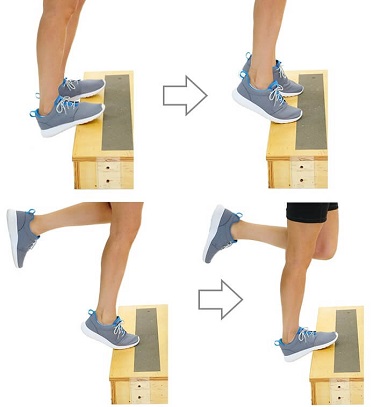
- Exercises: Strengthening exercises for the extensor muscles help to improve strength and endurance. Calf stretches can also help as having tight calves puts more strain on the extensor tendons
- Orthotics: Shoe insoles and inserts can be used to provide padding and support the foot, taking any undue tension off the tendons
- Physical Therapy: As well as working on a rehab programme with you, a physical therapist may use electrotherapy such as Ultrasound therapy to help promote healing
- Steroid Injections: If the pain fails to settle, a steroid injection can be given to help reduce the inflammation. Care must be taken as it does temporarily weaken the extensor tendon
Recovery Process
It can take anything from a few weeks to a few months to recover from extensor tendonitis. The earlier you start treatment, the quicker you are likely to recover.
Factors that can affect recovery time include the severity of the condition, the type of treatment used, age, overall health, and lifestyle choices. Other factors, such as stress levels, nutrition, and sleep, can also play a role in the recovery process.
It is really important to try and avoid any activities that bring on your pain with extensor tendonitis, and to wear comfortable fitting shoes, to allow the tendon time to heal. Failure to do so will lead to continued irritation of the tendon and slow healing.
The good news is, in most cases, people make a full recovery with the right treatment plan.
What Else Can Help
Extensor tendonitis is the most common cause of top of foot pain. One of the best ways to treat extensor tendonitis is with a program of stretching and strengthening exercises. Find out more about how to stretch and strengthen the calf muscles in the calf exercises section to help prevent and treat extensor tendinopathy and other common causes of foot pain.
Tendonitis can occur in a number of locations around the foot and ankle. Find out more in the foot tendonitis section, including:
- Achilles Tendonitis: a common cause of heel pain and
- Peroneal Tendonitis: causes pain at the back and outer side of the ankle
- Posterior Tibial Tendonitis: causes inner ankle pain
- Tibialis Anterior Tendonitis: causes pain across the front of the ankle
Extensor tendonitis is just one of the possible causes of pain on the top of the foot. If this isn't sounding quite like your problem, visit the Top Of Foot Pain section for help working out what else might be going on and how to treat it.
You may also be interested in the following articles:
- Side Foot Pain
- Foot Arch Pain
- Nerve Pain In The Foot
- Foot & Ankle Stretches
- Swollen Feet & Ankles
- Foot Numbness
- Foot Lumps & Bumps
Page Last Updated: 02/28/24
Next Review Due: 02/28/26
